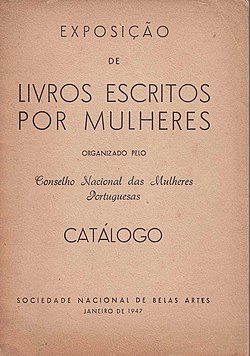Conselho Nacional das Mulheres Portuguesas
The Conselho Nacional das Mulheres Portuguesas (National Council of Portuguese Women) was a feminist organization founded in 1914.[1]

Early developments
The first attempt to found a Women’s Council in Portugal was at the beginning of the 20th century, when Carolina Michaëlis de Vasconcelos endeavoured to "bring together some ladies who speak English - and who wish to collaborate in the feminist movement" in order to meet a visiting Canadian feminist, Sophia Sanford. The idea was to try to form a National Council of Portuguese women, but the meeting was unsuccessful. Subsequently, the Conselho Nacional das Mulheres Portuguesas (CNMP) was founded on 30 May 1914, at the initiative of the politician and writer, Magalhães Lima, and the activist and gynecologist Adelaide Cabete, who was appointed president. Carolina Michaëlis de Vasconcelos was invited to be honorary president.[2]
Aims of the Council
The official bulletin of the Council, published in November 1914, stated that it aimed "to bring together, in a large association, all the associations and female groups that are spread throughout the country", putting an end to "alienation from the international feminist world". Its main objectives were the improvement of the legal situation of women in the family and in the State; the right to votes for women; the end of trafficking and exploitation of women; the improvement of public health; the defence of the rights of pregnant women and women who had recently given birth; and the protection of disadvantaged and abused women and children. Despite the Council’s apolitical approach, the fact that several prominent members of the Republican League of Portuguese Women, which advocated the overthrow of the monarchy, were part of the CNMP prevented the participation of more conservative, and, in general, more affluent women. As a consequence, the organization was short of funds and its headquarters, for most of its existence, were in the doctor’s office of Adelaide Cabete and her sister, Maria Brazão in Lisbon. However, in 1914 and 1915, there were fifteen affiliated associations.[2]
Activities
To celebrate the tenth anniversary of its foundation, the Council organized the First Feminist and Education Congress in Lisbon in May 1924, which was inaugurated by the President of the Republic, Manuel Teixeira Gomes. Twenty-five papers were presented, 17 by women. The proposals made in the presentations were very advanced for the time, such as that the working woman should be entitled to a month of maternity leave; sex education should be given in schools; equal pay should be given for equal positions; women should have the vote; and that married women and men should have the same legal status. In the following year representatives of the Council spoke at several international conferences. The successful first Lisbon congress led to the decision to hold another in 1928, which discussed issues such as coeducation in primary schools, votes for women, and the need to ensure that a woman who became pregnant would not be sacked.[2][3]
Throughout its life the Council communicated with its members through a bulletin. Initially known simply as the Bulletin of the Portuguese Women’s National Council, its name was changed to Alma feminina (The Feminine Soul) in 1917. It was changed again to A Mulher (The Woman) in 1946. The magazine was mainly concerned with publicizing the association's activities and initiatives promoted by international feminist and female organizations, as well as informing readers about the situation of women and the state of feminism in other countries.[2][4][5]
In 1930, on the initiative of journalist Maria Lamas, the council organised an "Exhibition of Female Work, ancient and modern, of a literary, artistic and scientific nature", with the support of the newspaper O Século. The purpose of the exhibition was to give visibility to the work of women from all over the country. Its success raised the profile of the CNMP. However, during the 1930s and 1940s, with the emergence of women's associations associated with the authoritarian Estado Novo government, the Council faced challenges as the State wanted women’s organizations that it could control.[2]
Closure
Although Adelaide Cabete lived in Portuguese Angola from 1929 to 1934, she continued to serve as president. On Cabete’s death in 1935 Sara Beirão was elected president. She was followed by Isabel Cohen von Bonhorst in 1942, and Maria Lamas in 1945. In 1947, after holding the successful "Exhibition of Books Written by Women" at the Great Hall of Fine Arts at the University of Lisbon, the Conselho Nacional das Mulheres Portuguesas was banned by the Estado Novo and had to immediately cease its operations. Nevertheless, many of the Council’s members continued to work to promote the rights of and better living conditions for Portuguese women, joining other associations that had not been banned.[2][6]
References
- ESTEVES, João. «Conselho Nacional das Mulheres Portuguesas». In Revista Faces de Eva. Estudos sobre a Mulher, n.º 15, Lisboa: Faculdade de Ciências Sociais e Humanas da Universidade Nova de Lisboa.
- Matias Pires Correia, Rosa de Lurdes. "O Conselho Nacional das Mulheres Portuguesas" (PDF). Universidade Novoa de Lisboa. Retrieved 21 June 2020.
- Neves, Helena. "O primeiro congresso feminista em Portugal realizou-se há 80 anos". Público. Retrieved 25 June 2020.
- Costa,, Célia Rosa Batista. "O Conselho Nacional das Mulheres Portuguesas (1914-1947)". Repositório Aberto. Retrieved 21 June 2020.CS1 maint: extra punctuation (link)
- "Alma feminina: boletim oficial do Conselho Nacional das Mulheres Portuguesas, Lisboa, 1917-1946". Biblioteca Nacional de Portugal. Retrieved 21 June 2020.
- "Conselho Nacional das Mulheres Portuguesas fechado há 70 anos". Delas. Retrieved 25 June 2020.